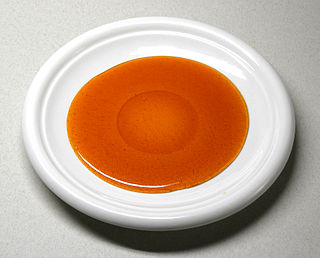
Cake is a flour confection made from flour, sugar, and other ingredients and is usually baked. In their oldest forms, cakes were modifications of bread, but cakes now cover a wide range of preparations that can be simple or elaborate and which share features with desserts such as pastries, meringues, custards, and pies.

Caramel is an orange-brown confectionery product made by heating a range of sugars. It is used as a flavoring in puddings and desserts, as a filling in bonbons or candy bars, or as a topping for ice cream and custard.

Belgian cuisine is widely varied among regions, while also reflecting the cuisines of neighbouring France, Germany and the Netherlands. It is characterised by the combination of French cuisine with the more hearty Flemish fare. Outside the country, Belgium is best known for its chocolate, waffles, fries and beer.

Pralines are confections containing nuts – usually almonds, pecans and hazelnuts – and sugar. Cream is a common third ingredient.

Icing, or frosting, is a sweet, often creamy glaze made of sugar with a liquid, such as water or milk, that is often enriched with ingredients like butter, egg whites, cream cheese, or flavorings. It is used to coat or decorate baked goods, such as cakes. When it is used between layers of cake it is known as a filling.

Cadbury Creme Egg is a chocolate confection produced in the shape of an egg. It originated from the British chocolatier Fry's in 1963 before being renamed by Cadbury in 1971. The product consists of a thick chocolate shell containing a sweet white and yellow filling that resembles fondant. The filling mimics the albumen and yolk of a soft boiled egg.

After Eight Mint Chocolate Thins, often referred to as simply After Eights, are a brand of mint chocolate covered sugar confectionery. They were created by Rowntree Company Limited in the UK in 1962 and have been manufactured by Nestlé since its acquisition of Rowntree in 1988.

A bonbon, sometimes bon-bon, is a small chocolate confection. They are sometimes filled with liqueur or other sweet alcoholic ingredients, and sold wrapped in colored foil.

Neuhaus is a Belgian chocolatier which manufactures and sells luxury chocolates, chocolate truffles, biscuits and ice cream. The company was founded in 1857 by Jean Neuhaus, a Swiss immigrant, who opened the first store in the Galeries Royales Saint-Hubert in central Brussels. In 1912, his grandson, Jean Neuhaus II, invented the chocolate praline, a decadent chocolate cream ganache center inside a chocolate shell, the original filled chocolate.

Quality Street is a line of tinned and boxed toffees, chocolates and sweets, first manufactured in 1936 by Mackintosh's in Halifax, West Yorkshire, England. It was named after J. M. Barrie's play Quality Street. Since 1988, the confectionery has been produced by Nestlé. Quality Street has long been a competitor to Cadbury Roses, which were launched by Cadbury in 1938. Nestlé does not distribute Quality Street in the US, but it may be ordered online for delivery, or found in specialty candy shops.

Cadbury Roses is a brand of chocolates made by Cadbury. Introduced in the UK in 1938, they were named after the English packaging equipment company "Rose Brothers" based in Gainsborough, Lincolnshire, that manufactured and supplied the machines that wrapped the chocolates.

A chocolate truffle is a French chocolate confectionery traditionally made with a chocolate ganache centre and coated in cocoa powder, coconut, or chopped nuts. A chocolate truffle is handrolled into a spherical or ball shape. The name derives from the chocolate truffle's similarity in appearance to truffles, a tuber fungus. It was created in the city of Chambéry by the pastry chef Louis Dufour.

Guylian is a Belgian chocolate brand and manufacturer best known for its seashell shaped pralines. The company was founded in 1958 in Sint-Niklaas, Belgium by Guy Foubert and is now owned by the South Korean company Lotte Confectionery.
Milk Tray is a brand of boxed chocolates currently manufactured by Cadbury. Introduced by Cadbury UK in 1915, it is one of the longest running brands in the confectioner's portfolio. Milk Tray is sold in Australia, Canada, Ireland, New Zealand, New York City, South Africa and the United Kingdom.

Belgian chocolate is chocolate produced in Belgium. A major industry since the 19th century, today it forms an important part of the nation's economy and culture.
Cavalier is a family-owned Belgian chocolate manufacturer founded in 1996, making only no-sugar-added chocolate products.

Vanparys Confiserie B.V. is a Belgian confectionery company founded in 1769 by Felix Vanparys in Brussels, near Sablon, Belgium. The company produces chocolate and sugar-coated confections but specializes in dragées, which features often in Christian and Islamic traditions and celebrations. The recipe and the preparation of its dragées, dates back over 125 years ago, and are still being continued today.

Camille Bloch is a Swiss chocolate producer based in Courtelary. It was founded in 1929 in Bern by Camille Bloch, a Bernese chocolatier, then moved to Courtelary in the Bernese Jura where production has been since 1935. The family business employed 180 people and in 2016, Camille Bloch produced about 3,500 tons of chocolate, generating sales of around 60 million francs.

Antwerp hands are a traditional regional delicacy from Antwerp, crafted in the shape of a hand. This distinctive shape harks back to the legend of the giant Druon Antigoon, who severed the hands of boatmen who refused to pay his toll. The giant was eventually slain by the hero Silvius Brabo, who then tossed Antigoon's hand into the River Scheldt.

















